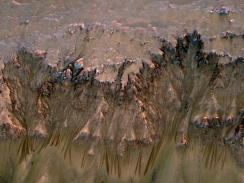We're open daily! View holiday hours
Science News
Mars Liquid Water
August 9, 2011

Water, when found in space, makes huge news. Whether it's on our moon, another moon or an asteroid, water could hint at signs of life. Maybe not life like that found on our planet, but something similar.
That’s why the news that NASA released last week, of potential signs of liquid salt water on our neighbor Mars, created such a splash!
Reporting in the journal Science, NASA researchers revealed that observations from the Mars Reconnaissance Orbiter (MRO) have revealed possible flowing water during the warmest months on Mars.
Dark, finger-like features appear and extend down some Martian slopes during late spring through summer, fade in winter, and return during the next spring. Repeated observations have tracked the seasonal changes in these recurring features on several steep slopes in the middle latitudes of Mars' southern hemisphere.
“The best explanation for these observations so far is the flow of briny water,” says lead author Alfred McEwen of the University of Arizona.
The flowing features are only about 0.5 to 5 yards or meters wide, with lengths up to hundreds of yards. The width is much narrower than previously reported gullies on Martian slopes. However, some of those locations display more than a thousand individual flows. Also, while gullies are abundant on cold, pole-facing slopes, these dark flows are on warmer, equator-facing slopes.
The MRO images show flows lengthen and darken on rocky equator-facing slopes from late spring to early fall. The seasonality, latitude distribution and brightness changes suggest a volatile material is involved, but there is no direct detection of one. The settings are too warm for carbon-dioxide frost and, at some sites, too cold for pure water. This suggests the action of brines, which have lower freezing points. Salt deposits over much of Mars indicate brines were abundant in Mars' past. These recent observations suggest brines still may form near the surface today in limited times and places.
These results are the closest scientists have come to finding evidence of liquid water on the planet's surface today. Purported droplets of brine also appeared on struts of the Phoenix Mars Lander. If further study of the recurring dark flows supports evidence of brines, these could be the first known Martian locations with liquid water.
“NASA's Mars Exploration Program keeps bringing us closer to determining whether the Red Planet could harbor life in some form,” NASA Administrator Charles Bolden said, “and it reaffirms Mars as an important future destination for human exploration.”
Image: NASA/JPL-Caltech/University of Arizona